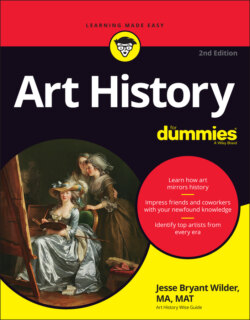Читать книгу Art History For Dummies - Jesse Bryant Wilder - Страница 88
Stare-down with God: Statuettes from Abu Temple
ОглавлениеPeople had statues like the Abu or Square Temple statuettes (see Figure 5-1a) set up in temples to commune directly with a god. I’m sure you’re thinking: Are these guys and gals bug-eyed aliens or did ancient Sumerians really look like this? The statuettes (the tallest is 30 inches high) represented real Sumerians but weren’t representative of their appearance. They are called votive statues because they’re surrogates for Sumerians who devoted themselves to, or made a vow to, their local god.
Bildarchiv Preussischer Kulturbesitz / Art Resource, NY
FIGURE 5-1: a) The statuette on the left, carved around 2700 BC, is one of twelve from the Square Temple in Eshnunna, modern day Tell Asmar. b) The female head of a goddess, on the right, from Uruk was carved between 3300 BC and 3000 BC.
Okay, but why are they bug-eyed? In horror movies, people’s eyes bulge cartoonishly when they spot a ghost. The ancient Sumerians’ eyes popped when they saw a god. Being bug-eyed meant you were devout; it showed that you were awestruck in the god’s presence and that you couldn’t take your eyes off of him or her. Even though the people of Tell Asmar (where the Abu Temple is located) didn’t have bug eyes, the clothes, beards, and hairdos of the statuettes probably roughly mirrored the Sumerians. Tell Asmar was a small town, and their sculptors weren’t as polished, so to speak, as big-city artists in Ur and Uruk.
Compare the description of Square Temple statuettes to the sensitively rendered mask of a god from Uruk carved approximately 500 years earlier (see Figure 5-1b), about the time the Sumerians invented writing. The mask’s eyes were most likely filled with colored stones; the eyebrows and hair were probably wrought of gold or copper, which disappeared long ago. The Square Temple statuette’s eyes are inlaid with shell and black limestone.
Early Egyptian statues seem squared-off and rectangular (see Chapter 6), but Sumerian statues appear cylindrical. In fact, Sumerian artists based the human body on the cylinder and cone. Conelike skirts flair out on the Square Temple statuettes, most of which are men. Their legs are cylinders, and their braids look like corrugated vacuum-cleaner hoses. Staircase-like beards distinguish most of the men. One of the women is bald and looks like a female Uncle Fester, minus the light bulb.
